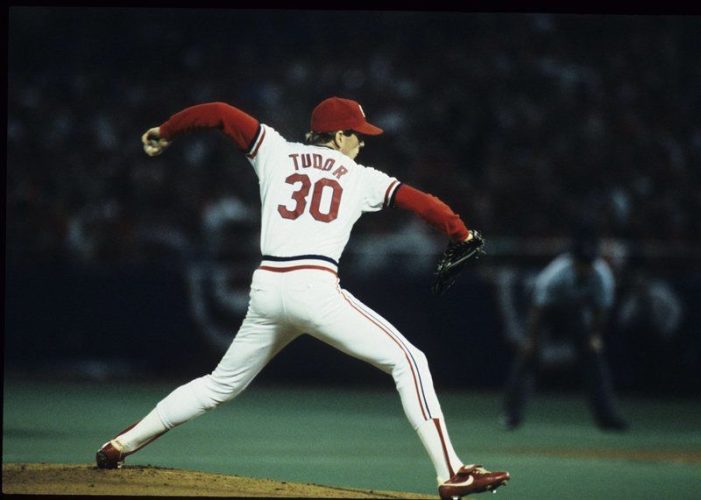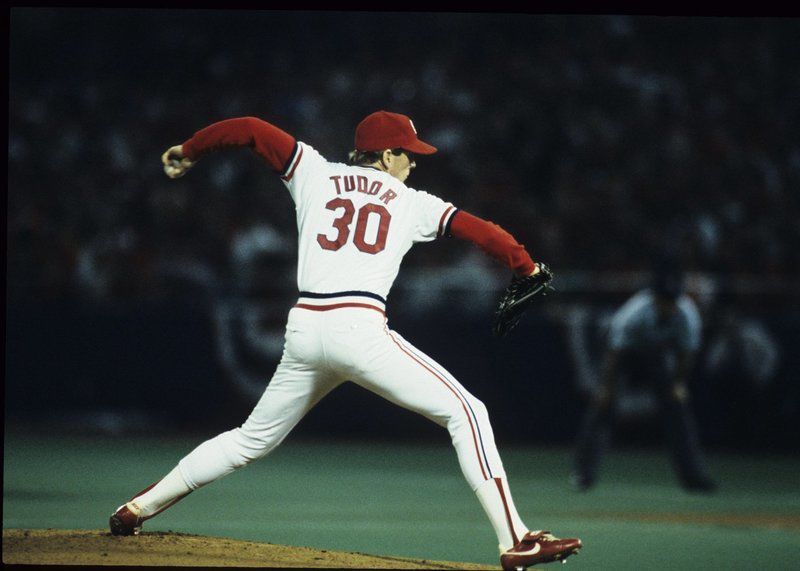John Tudor
Position: Pitcher Bats: Left • Throws: Left 6-0, 185lb (183cm, 83kg) Born: February 2, 1954 in Schenectady, NY Draft: Drafted by the New York Mets in the 21st round of the 1975 MLB June Amateur Draft from Georgia Southern University (Statesboro, GA) and the Boston Red Sox in the 3rd round of the 1976 MLB January Draft-Secondary Phase from Georgia Southern University (Statesboro, GA). Schools: North Shore Community College (Danvers, MA), Georgia Southern University (Statesboro, GA) Debut: August 16, 1979 (11,833rd in MLB history) vs. CHW 2.2 IP, 6 H, 1 SO, 2 BB, 3 ER Last Game: September 13, 1990 vs. MON 2.0 IP, 2 H, 0 SO, 0 BB, 0 ER Full Name: John Thomas Tudor View Player Bio from the SABR BioProject
Nine Other Players Who Debuted in 1979
Rickey Henderson
Tim Raines
Kirk Gibson
Dickie Thon
Jesse Orosco
Jeff Reardon
Dan Quisenberry
Dave Righetti
Dave Stieb
All-Time Teammate Team
Coming Soon
Notable Events and Chronology
Biography
Tudor’s brief stint in the baseball spotlight was somewhat dimmed because of his unwillingness to cooperate with the press. Often overwhelmed by media attention, especially after tough games, the southpaw became unfairly known for a cold nature with the media, though teammates defended him as a very warm person. Nothing much affected his pitching in 1985, however, when he finished second in the Cy Young Award balloting. But Tudor enjoyed just a few seasons as a top National League pitcher before an elbow injury ended his career. Tudor honed his talents as a lefthander in the shadow of Fenway Park’s Green Monster. After a 1-2 record in his first call-up, he went 8-5 with a 3.03 ERA in 1980 and didn’t have a losing record in the ’80s. After two straight 13-win seasons, he went to the Pirates in return for Mike Easler for the 1984 season and went 12-11 for the first team ever to lead the league in ERA but finish last in the standings. Tudor experienced his greatest season in 1985, despite a 1-7 start after coming from the Pirates with Brian Harper in return for George Hendrick and a minor leaguer. With every loss, Tudor got more incensed at the press for badgering him. His terse answers and eye rolling to journalists’ questions made him a target as an arrogant ballplayer by the media. But despite the bad picture painted of him, Tudor completely turned his season around — with the help of his high school catcher, who noticed a flaw in Tudor’s delivery while watching a Cardinals game on TV. On the advice of his old teammate, Tudor adjusted his pitching motion and won 20 of his last 21 decisions. The lefty’s emergence on the mound more than compensated for Joaquin Andujar’s poor pitching in the stretch as the Cardinals won the title. Tudor finished 1985 at 21-8 with a 1.93 ERA and led the National League with ten shutouts. He would have been a lock for the Cy Young Award had Dwight Gooden not enjoyed an even more brilliant season. Tudor finished second to Gooden in ERA, wins (tied for second), complete games (tied for second), and innings pitched. After losing the first game of the League Championship Series 4-1, Tudor came back to win game four 12-2. In the World Series, he pitched masterfully at first, winning Game One 3-1 and throwing a five-hit shutout to win Game Four 3-0. But he was knocked out in the third inning of Game Seven, allowing five runs to the Kansas City Royals. He punched a rotating fan in the clubhouse, severely cutting his hand, and was even surlier than usual to members of the press. After his fine 1985 campaign, Tudor was plagued by injuries. He continued his fine performance in 1986, going 13-7 with a 2.92 ERA, but missed the final three weeks of the season and had his fewest complete games (three) since 1981. He missed over three months in 1987 after New York Mets catcher Barry Lyons fell into the St. Louis dugout and broke Tudor’s leg; Tudor finished 10-2 but had a 3.84 ERA. That postseason, Tudor lost Game Two 5-0 to the San Francisco Giants and tied a National League Championship Series record by allowing ten hits. Combining with Todd Worrell and Ken Dayley, he won Game Six 1-0. Tudor then won Game Three of the World Series 3-1, but was knocked out of Game Six, when he allowed four hits and four runs in the fifth inning without retiring a batter. Starting 1988 on the disabled list, Tudor was traded to the Los Angeles Dodgers in mid-August for Pedro Guerrero. The Mets hit him hard in his no-decision in Game Four of the LCS, and he had to take himself out of Game Three of the World Series in the second inning with an elbow injury. The same injury limited him to just 8 1/3 innings in three games in 1989 and eventually ended his career despite a fine comeback season with the Cardinals in 1990.
Factoids, Quotes, Milestones and Odd Facts
Coming soon
Other Resources & Links
Coming Soon
If you would like to add a link or add information for player pages, please contact us here.







